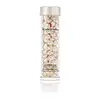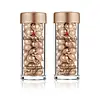What's inside
What's inside
 Key Ingredients
Key Ingredients

 Benefits
Benefits

 Concerns
Concerns

No concerns
 Ingredients Side-by-side
Ingredients Side-by-side

Dimethicone
EmollientCaprylic/Capric Triglyceride
MaskingDimethicone/Vinyltrimethylsiloxysilicate Crosspolymer
Silica
AbrasiveEthylhexyl Palmitate
EmollientC12-15 Alkyl Benzoate
AntimicrobialDimethiconol
EmollientButylene Glycol
HumectantCeramide Ng
Skin ConditioningCeramide NP
Skin ConditioningCeramide Ns
Skin ConditioningCyclopentasiloxane
EmollientDiethylhexyl Syringylidenemalonate
Skin ProtectingEthylhexyl Cocoate
EmollientHelianthus Annuus Seed Oil
EmollientHydrogenated Castor Oil
EmollientHydrolyzed Sodium Hyaluronate
Skin ConditioningLactic Acid
BufferingLecithin
EmollientOlea Europaea Fruit Oil
MaskingPalmitoyl Hexapeptide-12
Skin ConditioningPEG-10 Phytosterol
EmulsifyingPentylene Glycol
Skin ConditioningPersea Gratissima Oil
Skin ConditioningPhytosphingosine
Skin ConditioningPhytosterols
Skin ConditioningPropylene Glycol Dicaprylate/Dicaprate
EmollientRicinus Communis Seed Oil
MaskingSilica Dimethyl Silylate
EmollientSodium Hyaluronate
HumectantTribehenin
EmollientZingiber Zerumbet Extract
Skin ConditioningPhenoxyethanol
PreservativeDimethicone, Caprylic/Capric Triglyceride, Dimethicone/Vinyltrimethylsiloxysilicate Crosspolymer, Silica, Ethylhexyl Palmitate, C12-15 Alkyl Benzoate, Dimethiconol, Butylene Glycol, Ceramide Ng, Ceramide NP, Ceramide Ns, Cyclopentasiloxane, Diethylhexyl Syringylidenemalonate, Ethylhexyl Cocoate, Helianthus Annuus Seed Oil, Hydrogenated Castor Oil, Hydrolyzed Sodium Hyaluronate, Lactic Acid, Lecithin, Olea Europaea Fruit Oil, Palmitoyl Hexapeptide-12, PEG-10 Phytosterol, Pentylene Glycol, Persea Gratissima Oil, Phytosphingosine, Phytosterols, Propylene Glycol Dicaprylate/Dicaprate, Ricinus Communis Seed Oil, Silica Dimethyl Silylate, Sodium Hyaluronate, Tribehenin, Zingiber Zerumbet Extract, Phenoxyethanol
Dicaprylyl Carbonate
EmollientCoco-Caprylate/Caprate
EmollientDimer Dilinoleyl Dimer Dilinoleate
EmollientTetrahexyldecyl Ascorbate
AntioxidantTocopheryl Acetate
AntioxidantC12-15 Alkyl Benzoate
AntimicrobialCaprylic/Capric Triglyceride
MaskingCeramide NP
Skin ConditioningCeramide Ns
Skin ConditioningDiethylhexyl Syringylidenemalonate
Skin ProtectingGlyceryl Dioleate
EmollientHelianthus Annuus Seed Oil
EmollientOlea Europaea Fruit Oil
MaskingPersea Gratissima Oil
Skin ConditioningPhytosphingosine
Skin ConditioningPhytosterols
Skin ConditioningPropylene Glycol Dicaprylate/Dicaprate
EmollientSclareolide
MaskingTocopherol
AntioxidantTriolein
Skin ConditioningPhenoxyethanol
PreservativeDicaprylyl Carbonate, Coco-Caprylate/Caprate, Dimer Dilinoleyl Dimer Dilinoleate, Tetrahexyldecyl Ascorbate, Tocopheryl Acetate, C12-15 Alkyl Benzoate, Caprylic/Capric Triglyceride, Ceramide NP, Ceramide Ns, Diethylhexyl Syringylidenemalonate, Glyceryl Dioleate, Helianthus Annuus Seed Oil, Olea Europaea Fruit Oil, Persea Gratissima Oil, Phytosphingosine, Phytosterols, Propylene Glycol Dicaprylate/Dicaprate, Sclareolide, Tocopherol, Triolein, Phenoxyethanol
Ingredients Explained
These ingredients are found in both products.
Ingredients higher up in an ingredient list are typically present in a larger amount.
C12-15 Alkyl Benzoate is made up of Benzoic Acid and long chain alcohols. It has a low molecular weight.
C12-15 Alkyl Benzoate is an emollient and texture enhancer. Due to its solubility, it is often used in sunscreens to help evenly distribute active ingredients.
As an emollient, C12-15 Alkyl Benzoate helps soften and hydrate your skin. Emollients create a film on your skin that traps moisture within.
This ingredient has been reported to cause eye irritation.
Learn more about C12-15 Alkyl BenzoateThis ingredient is an emollient, solvent, and texture enhancer. It is considered a skin-softener by helping the skin prevent moisture loss.
It helps thicken a product's formula and makes it easier to spread by dissolving clumping compounds.
Caprylic Triglyceride is made by combining glycerin with coconut oil, forming a clear liquid.
While there is an assumption Caprylic Triglyceride can clog pores due to it being derived from coconut oil, there is no research supporting this.
Learn more about Caprylic/Capric TriglycerideCeramide NP is a type of ceramide and formally known as ceramide 3.
Ceramides are intercellular lipids naturally found in our skin that bonds dead skin cells together to create a barrier. They are known for their ability to hold water and thus are a great ingredient for dry skin.
Ceramides are an important building block for our skin barrier. A stronger barrier helps the skin look more firm and hydrated. By bolstering the skin ceramides act as a barrier against irritating ingredients. This can help with inflammation as well.
If you would like to eat ceramides, sweet potatoes contain a small amount.
Read more about other common types of ceramides here:
Ceramide AP
Ceramide EOP
Ceramide NS is formally known as Ceramide 2. It is one of the major ceramides in the stratum corneum (outermost layer of skin) plays a role in forming a protective barrier.
Due to its structure, skin lipids can be packed tightly and in turn, this strengthens the barrier and reduces water loss.
Studies show conditions like atopic dermatitis can worsen when ceramide NS levels are low.
Learn more about Ceramide NsDiethylhexyl Syringylidenemalonate (DESM) is a photostabilizer, antioxidant, and SPF booster.
One of DESM's main roles is stabilizing UV filters, especially avobenzone. Avobenzone is notoriously unstable when exposed to sunlight. By enhancing the stability of these filters, DESM helps maintain the sunscreen's effectivess through wear. It also helps improve protection against long-wave UVA rays by increasing the wavelength of the formula.
Besides enhancing UVA protection, DESM can boost the SPF of high-SPF formulations by up to 5 units.
DESM also preserves the color integrity of cosmetic products and helps reduce the chance of yellowing of fading due to light exposure.
This ingredient is typically found in concentrations between 0.3% - 0.5%. There are currently no maximum usage limits by regulatory bodies.
Though this ingredient is a chemical UV filter, it can often be found in "100% mineral" sunscreens. This is due to regulatory loopholes.
Learn more about Diethylhexyl SyringylidenemalonateHelianthus Annuus Seed Oil is the oil derived from the seeds of a Sunflower. Sunflower seed oil is non-fragrant. It is an emollient, meaning it helps to soften the skin.
Sunflower seed oil contains many fatty acids. The fatty acids found in sunflower seeds include (from highest amount to least): linoleic acid, myristic acid, palmitic acid, stearic acid, arachidic acid, oleic acid, and linolenic acid.
These fatty acids help the skin create ceramides. Ceramides play a role in repairing the skin barrier.
Helianthus Annuus Seed Oil helps moisturize the skin. This in turn helps the skin look more rejuvenated and smoother.
Sunflowers are rich in vitamin E.
Historians believe Indigenous cultures of North America domesticated sunflowers before corn. Thus they relied on sunflower oil for a variety of uses. One such use is moisturizing skin and hair.
Sunflower seed oil may not be fungal acne safe. We recommend speaking with a professional if you have any concerns.
Learn more about Helianthus Annuus Seed OilOlea Europaea Fruit Oil is the fixed oil obtained from the ripe fruit of the Olive. In other words - olive oil.
The primary contents of olive oil are glycerides of the fatty acids linoleic, oleic and palmitic.
Olive oil also contains antioxidants such as Vitamin E. Antioxidants may help reduce signs of aging by fighting unstable free-radical molecules. It also contains Vitamins A (retinol), D, and K.
The squalene in olive oil makes it a great emollient. Emollients help soothe and soften your skin by trapping moisture in. This makes olive oil a great skin moisturizer.
Studies show olive oil to have antibacterial and antifungal properties in low concentrations. Another study found olive oil irritated sensitive oily skin. We always recommend speaking with a professional about using this ingredient in your routine.
Due to the fatty acid content, this ingredient may not be fungal-acne safe.
Learn more about Olea Europaea Fruit OilPersea Gratissima Oil is also known as avocado oil.
Avocado Oil has antioxidant properties. It is mostly made up of the glycerides of fatty acids. About 67% of these fatty acids is made up of oleic acid. Palmitic acid and linoleic acid are also present.
These fatty acids help hydrate and soften the skin. It may increase collagen content in the skin. Collagen helps keep your skin plump and firm. This ingredient helps reduce inflammation and has not shown to clog pores.
This ingredient may not be fungal-acne safe due to its high fatty acid content.
Avocados also have B vitamins, vitamin K, vitamin C, vitamin E, and potassium.
Learn more about Persea Gratissima OilPhenoxyethanol is a preservative that has germicide, antimicrobial, and aromatic properties. Studies show that phenoxyethanol can prevent microbial growth. By itself, it has a scent that is similar to that of a rose.
It's often used in formulations along with Caprylyl Glycol to preserve the shelf life of products.
Phytosphingosine is a phospholipid naturally found in our skin as a building block for ceramides.. It helps moisturize, soothe, and protect skin.
Phytosphingosine contributes to your skin's natural moisturizing factor (NMF). The NMF is responsible for hydration, a strong barrier, and plasticity. Our NMF decreases with age. Increasing NMF leads to more healthy and hydrated skin.
Studies show products formulated with NMF ingredients help strengthen our skin's barrier. Having a healthy skin barrier reduces irritation and increases hydration. Our skin barrier is responsible for having plump and firm skin. It also helps protect our skin against infection, allergies, and inflammation.
Fun fact: Phytosphingosine is abundant in plants and fungi.
More ingredients that help boost collagen in skin:
Learn more about PhytosphingosinePhytosterols come from plants, nuts, and whole grains. These compounds have skin soothing and moisturizing properties.
Fun fact: They are similar to cholesterol and can help lower cholesterol levels.
Propylene Glycol Dicaprylate/Dicaprate is a mixture of Propylene Glycol Dicaprylate and Propylene Glycol Dicaprate.
It is an emollient and helps hydate the skin.